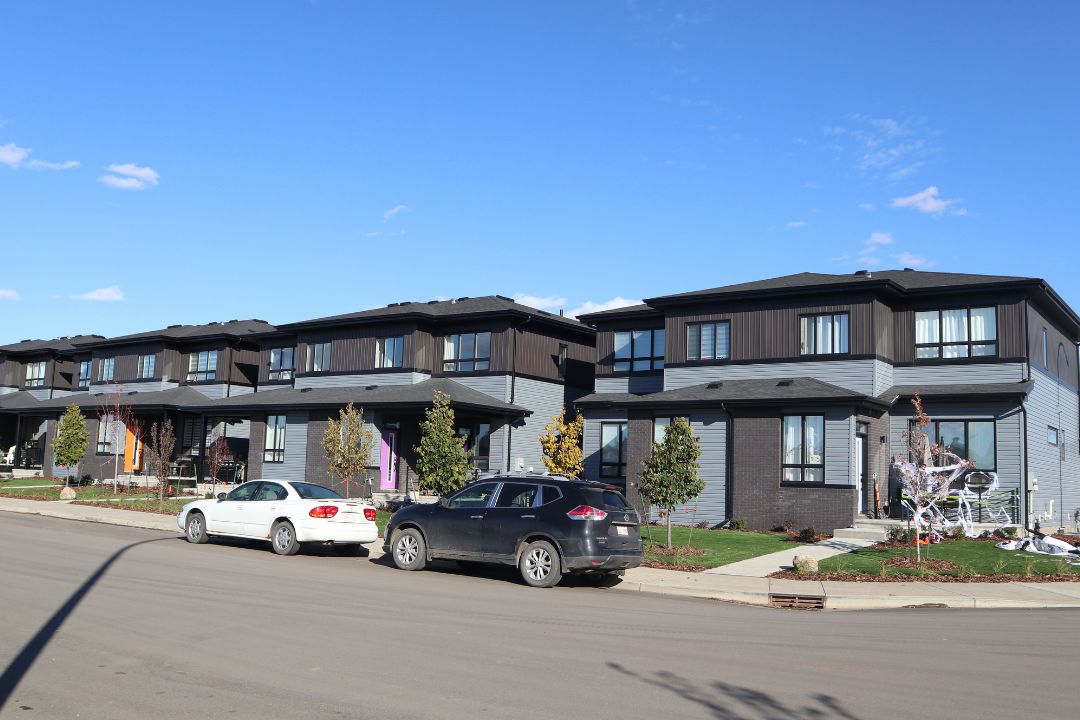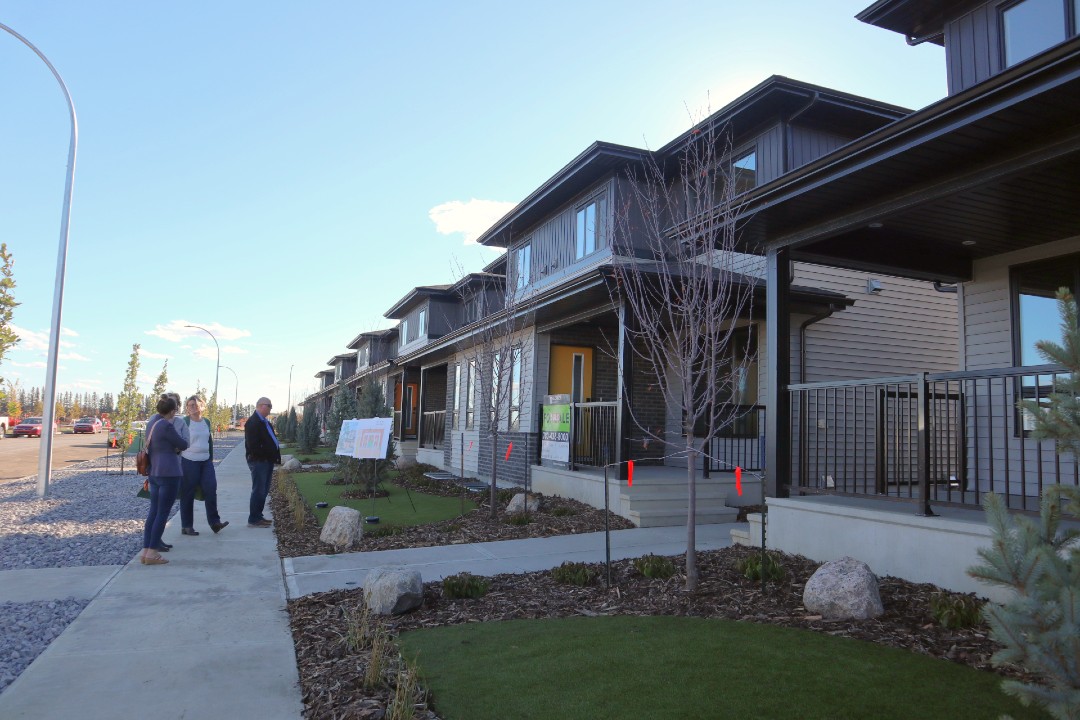While multi-family buildings of six, 10, and 40 storeys sprout up in central Edmonton, a developer is building density differently in another part of the region.
Strata Developments is working with home-builder JL Developments to test market reaction to several new, medium-density styles of housing in its Southfort Meadows neighbourhood in Fort Saskatchewan.
"People have huge concerns about density being near them, and I think the biggest concerns are for projects that are highly vertical adjacent to something that's two and a half storeys or lower," Andrew Usenik, a partner at Strata Developments, told Taproot. "We're able to capture all the benefits of those densities, but still have a housing product that I think most people will be more accepting of."
Along Greenfield Link in the new neighbourhood now stands a row of duplexes with double garages. Fort Saskatchewan city council rezoned the lots to a direct control zone to allow them to be 22.5 metres deep (the measurement from front to back for a lot), far shallower than a typical duplex lot, which is about 35 metres deep. The homes also don't have backyards, a rare building type.
"When we put together the idea, the hypothesis that we were trying to test was that not every buyer in the market wants or needs a backyard," Usenik said. "Ninety-five percent of our community is different kinds of houses with backyards, but we thought that the market would be large enough to be able to justify doing this one project."
A few groups of people were interested in living in homes without a backyard, Usenik said, especially because the front yards don't have a typical grass lawn that needs to upkeep. One were retirees who are downsizing and spend part of the year in warmer climates. Another were industrial workers who spend weeks working in the oil patch and don't want to spend time doing yardwork on their days off. Yet another were single parents, whose kids play in the large park across the street instead of in a private backyard.
"We measured out the distance between the front door to the park, versus the front door to where the backyard would be, and it was literally a shorter distance from the front door to the park," Usenik said.
Thanks to the shallower lot size, the duplexes have a density of 55 units per net developable hectare, instead of a typical rowhouse, which would have 35 to 40 units per NDH. The Edmonton Metropolitan Region Board growth plan sets Fort Saskatchewan's minimum density at 35 units per NDH.
Farther down Greenfield Link, there are a row of duplexes with basement suites. Strata also had to get these lots rezoned because Fort Saskatchewan's zoning bylaw does not allow basement suites in duplexes.

Rowhouses with no backyards in Fort Saskatchewan's Southfort Meadows neighbourhood. (Stephanie Swensrude)
Usenik said Strata was able to convince Fort Saskatchewan council to approve the development because it had two separate single-car garages in the back. The garages are attached to the home, with one leading to the upstairs and one leading downstairs. "A lot of the municipalities around Edmonton, one of the biggest issues you get to in any council meeting is parking, parking, parking. It is such a huge thing," he said. "By making that tweak to design and addressing that both occupants had their own access to private parking, I think it went a long way with council."
The basement suites are one-bedroom units and have been rented out for between $700 to $900 per month, Usenik said. The average monthly rent for a one-bedroom apartment in the Edmonton region was $1,384 in November. The suites act as an alternative to apartment buildings with uncovered surface parking, which Usenik said is the most common option for single-bedroom units in Fort Saskatchewan.
"There is a large industrial base in Fort Saskatchewan, people with large trucks that they need for work. That's the kind of person who doesn't need 1,700 square feet (of space) in their apartment, but would definitely value a private, safe, enclosed garage space to go along with the living space that's most appropriate for them," Usenik said.
The duplexes are as dense per NDH as a six-floor apartment building could be in Fort Saskatchewan, Usenik said. This is partially because Fort Saskatchewan requires buildings to have a minimum number of off-street parking spaces (Edmonton abolished parking minimums in 2020).
In a typical suburban context, a four-storey apartment building will have a density of about 90 units per NDH and a six-storey apartment building will have about 100 units per NDH. "The reason that there's not a big, drastic change between those two is because when you add those two extra floors and the extra units that go along with it, you have to expand the footprint of your site as well to be able to cover the extra parking," Usenik said. This wouldn't apply if the building had underground parking, but Usenik said building underground parking in the suburbs just doesn't work financially.

Duplexes with basement suites in Fort Saskatchewan's Southfort Meadows neighbourhood. (Stephanie Swensrude)
Strata is working on the next phase of the neighbourhood, which will be similar to the duplexes with basement suites but will have front-attached garages.
Usenik said building housing like this means residents of all income levels can more easily coexist in a neighbourhood. One of the duplexes with basement suites is currently for sale for $399,000. It has 1,410 square feet of living space, three bedrooms, and two and a half bathrooms. There are only 17 three-bedroom duplexes at the same price point for sale in Edmonton as of mid-November, and none of them have as much living space.
These houses along Greenfield Link will be dense, but not walkable. The nearest grocery store is farther than two kilometres away, for example. The density of people will also mean a density of vehicles. When asked if Strata expects traffic congestion once the neighbourhood is fully populated, as most trips will require a car, Usenik said he doesn't foresee a problem.
When a developer builds a new neighbourhood, it must pay a levy to the municipality that will fund future transportation projects to serve the projected population of the neighbourhood. In suburban contexts, this usually means wider roads. Usenik said Fort Saskatchewan has been a good treasurer for this fund, and typically adds third and fourth lanes to roads before it's necessary.
"We just haven't ran into any congestion issues in our 20 years there through development, because we've always had the roads that are needed when they're needed," Usenik said. "Where we see gridlock today in the suburban context, it's, quite frankly, underfunded infrastructure."
